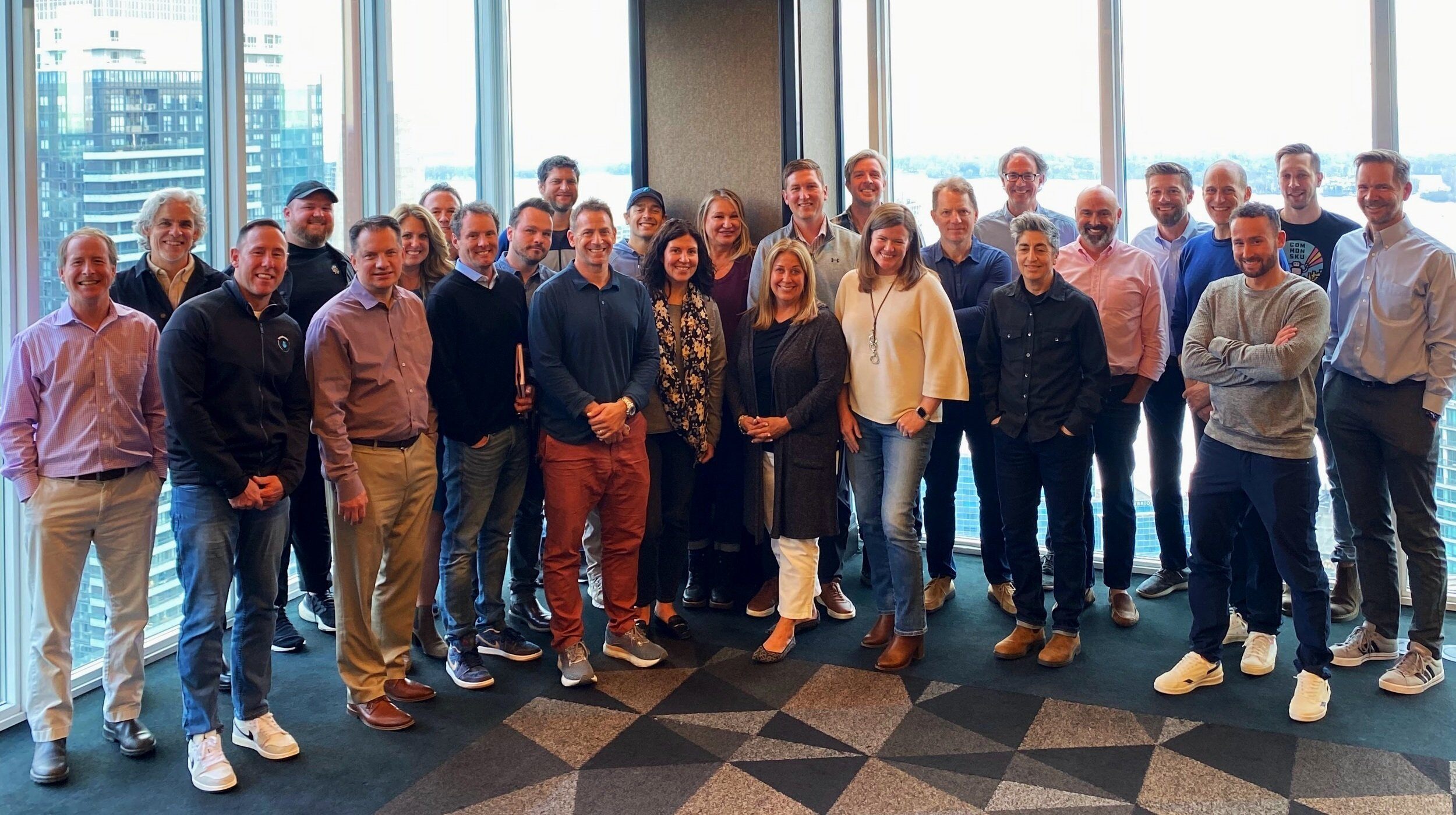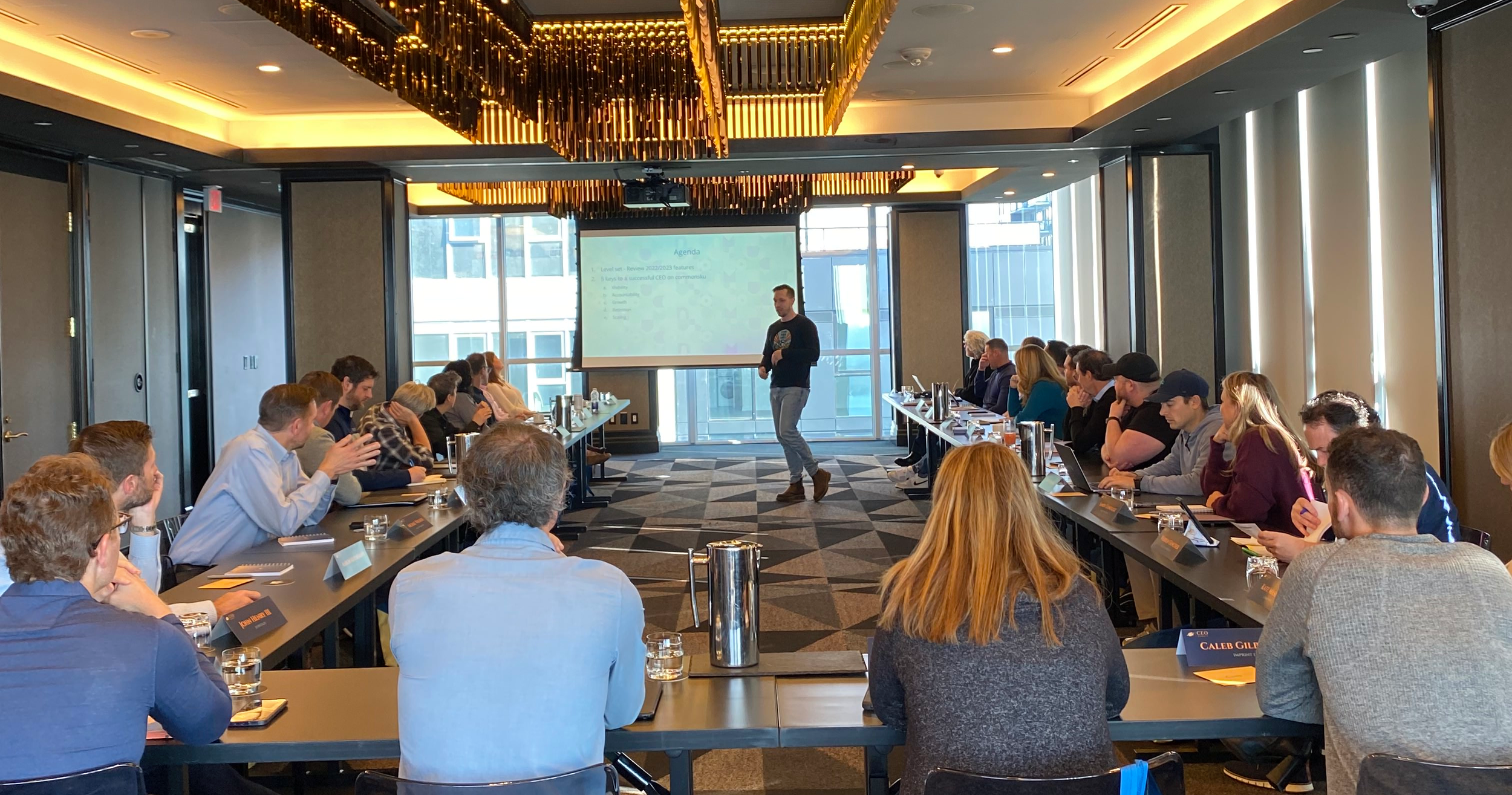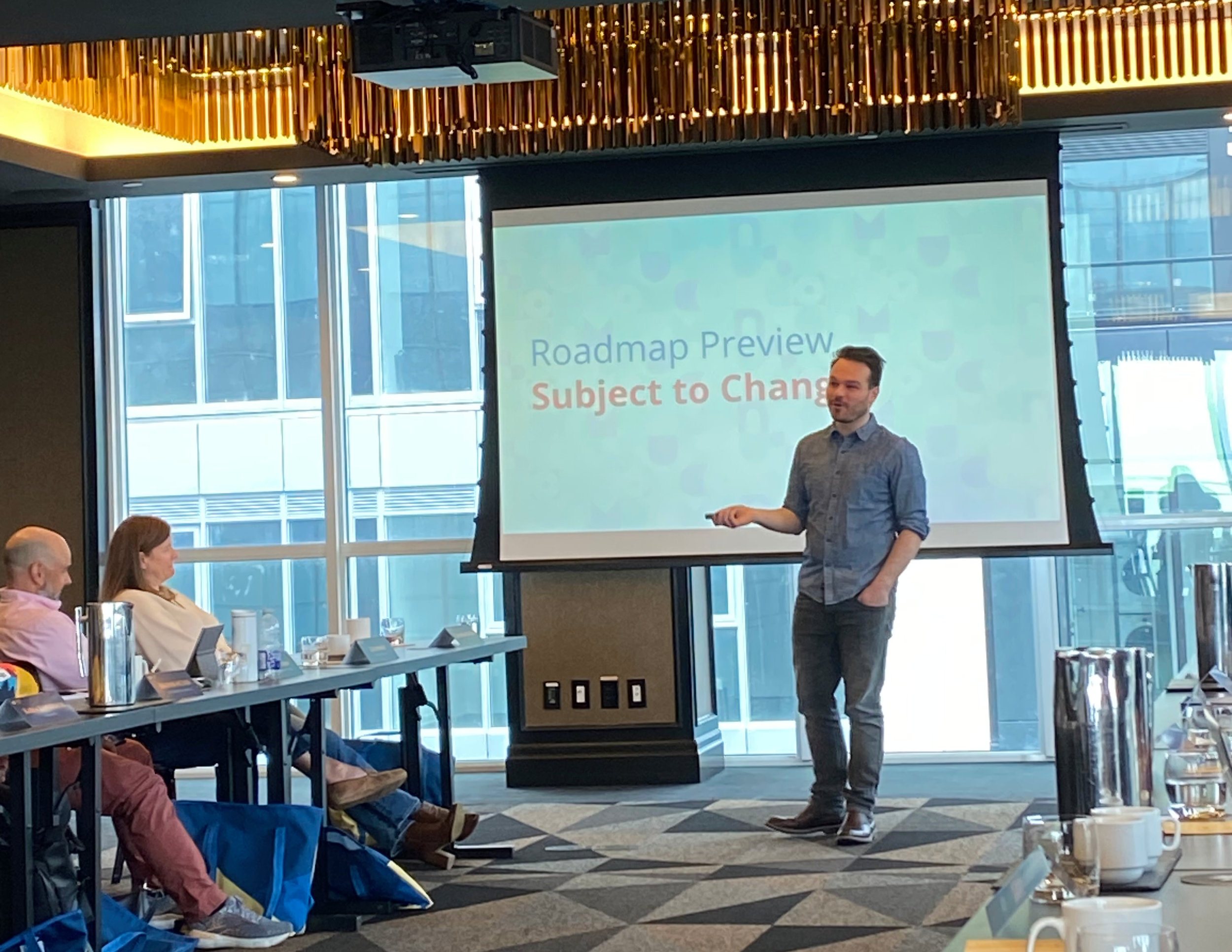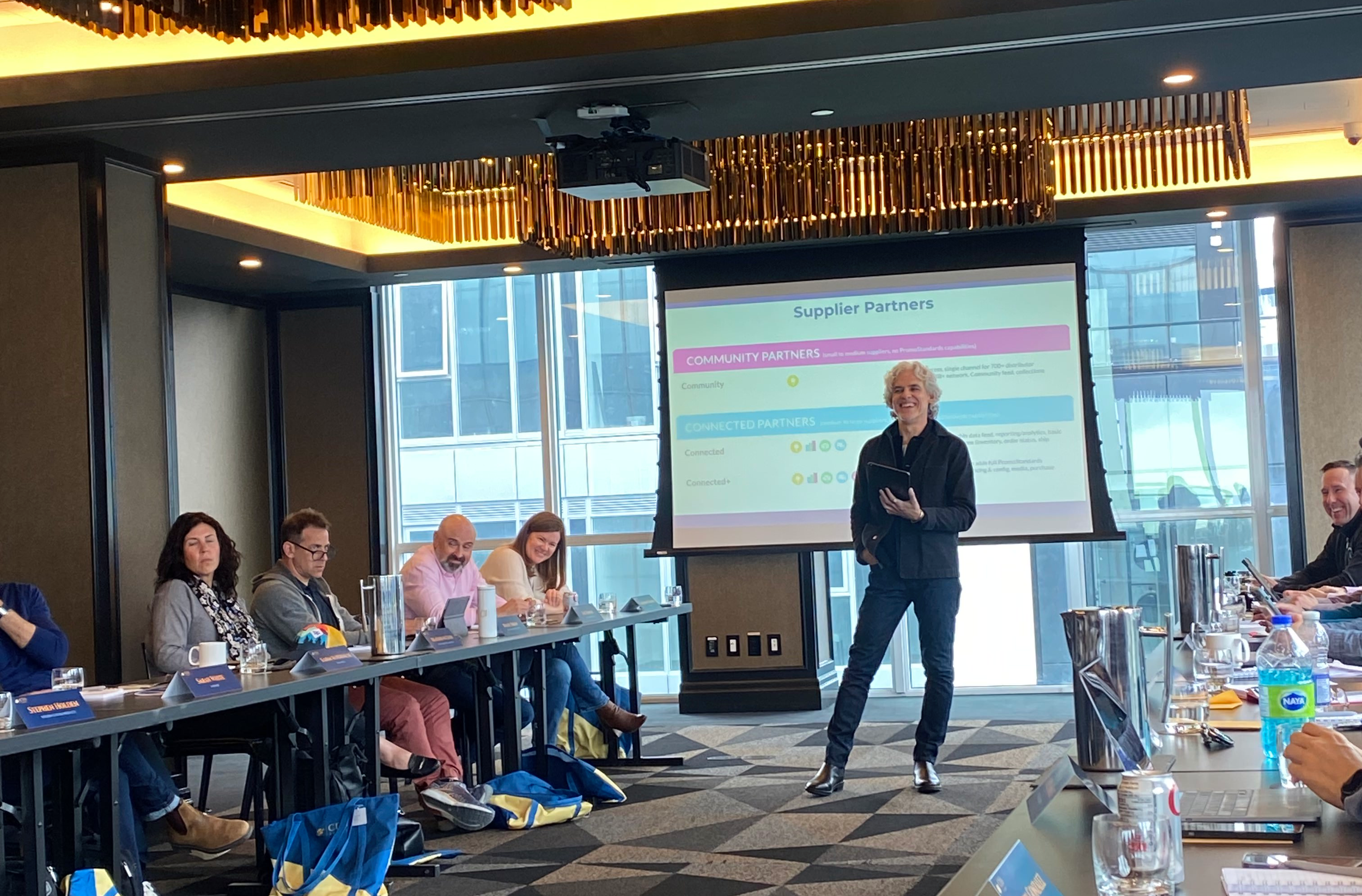16 Inspiring Ideas and Bold Trends from commonsku’s CEO Summit

“The evolution of growth in a distributor’s journey has three crucial inflection points,” said Joe Sommer with Whitestone Branding, “getting to $3 million is one, then growing from $3 million to $10 is another, and then, growing from $10 million to the $40+ million stage. At each stage, the CEO needs to evolve.”
These words, from commonsku’s first CEO Summit, held at the beautiful Bisha Hotel in downtown Toronto, encapsulated the mission of the event. Over 20 top executives from some of the largest distributorships in the industry, gathered to connect and share best practices on topics ranging from AI to sales incentives and compensation, team structure, HR and culture, and more.
One thing they each had in common? They each use commonsku to power their business. But as each CEO began to share more of their story, the similarities began to fade. What emerged was a commonality in challenges and opportunities but also, very distinct approaches to how they structure their teams, how they go to market, and how they envision their future.
The CEO Summit included two hosted dinners as well as a full day of topic-by-topic peer learning, and the event kicked off with Aaron Kucherawy (commonsku’s VP of Customer Success) sharing “How Leaders Make the Most of commonsku,” and a mid-morning session introducing Charlie Moscoe (commonsku’s Vice President of Product Development) who demonstrated how we prioritize client-led platform development, as well as a glimpse into the current and future roadmap.


Mark Graham, commonsku’s President and Chief Brand Officer, said, “Our objective with CEO Summit was to bring together a group of commonsku customers who are all about the same size in teams and revenue to accomplish three things: To create a full-day of collaboration and best-practice sharing; to give our executive team a chance to listen and learn from their unique challenges; and to share our development work in progress including a glimpse at future ideas that would create even more efficiency and growth.”


From the full day’s agenda of peer-led discussions, here are 16 top trends, tips, and resources that shape some of the most progressive distributors today:
-
From traditional reps to team selling model: Team selling is the norm, or what Caleb Gilbertson with Imprint Engine calls a “pod structure for teams.” Team selling is not only a great solution for clients but also for employees as it creates an organic mentorship and apprenticeship model for training. Plus, with less reliance on one person as a contact to the customer, you mitigate the pressure and improve overall team health. You can also manage better each team’s progress as its own business unit.
-
Focus teams by specialty or vertical: Many in the room agreed with a team selling model, with some focusing their teams by specialty or vertical. Josh Kosinski with Sky High has an e-com team and is currently working through ideas to concentrate more of their teams on specific niches of expertise.
-
Hiring upper management: One challenge every owner faces is becoming a bottleneck for growth. Hiring upper management with clearly defined roles and goals is a crucial step for CEOs. “Getting out of your own way.” But also, finally being freed to “work on the business rather than in the business.” And mostly, Joe Sommer stressed that creating a solid organizational structure creates clear paths to growth for those wishing to grow in the company.
-
HR roles are on the rise: Half of the participants said they have a dedicated HR role or a fractional HR Director. HR is becoming a crucial role and is particularly needed once an organization grows beyond a certain level. Other roles on the rise? COO, Director of Marketing, Supply Chain Managers.
-
Referral bonuses and assessments: When it comes to recruiting the right type of employee, many CEOs have implemented a referral bonus with their teams, and also, use assessments to aid with the hiring process.
-
The CEO advisory board: Just as your team structure won’t be the same as when you began, neither will you. Hiring a coach or an advisory board is one way for a CEO to help get themselves and their team to the next level. And because of this, ⅓ of the room has implemented some form of EOS system or borrowed from EOS principles (as featured in Traction), or use tools like bloom growth to help navigate through seasons of growth.
-
Adopting and integrating gold standards: Ritz Carlton does it right, so, why reinvent the wheel? Adopt the Ritz Carlton Gold Standards or modify their standards for you and your team as your company values.
-
Shrink to grow: Many in the room agreed with the idea that often you have to shrink your client base in order to grow, meaning, winnowing out poor-performing clients or lackluster sales is a crucial part of growing. One distributor stated that success to them is growing the topline exponentially by increasing their client size and reducing overall total clients, “growing from 500 clients to 100 (of the right kinds of) clients.”
-
Expanding globally might mean putting down roots: There was a general consensus in the room by those who have already done it that global expansion might mean opening offices overseas though there is this exception to the rule. Most distributors in the room face overseas pressure to perform for international clients.
-
Growth by acquisition: Almost all of the distributors in the room were open to growth by acquiring other distributors and strategically considering it a part of their future strategy. One distributor shared his experience growing both organic sales as a comparison against merging or acquiring another distributor, stressing that acquisitions/mergers take the right fit and take time, but they can often outperform traditional organic growth.
-
AI is being adopted, fast: Tools like Gong and Seamless.AI and Hubspot’s AI integration were mentioned as tools used for lead gen and sales training. One distributor is using ChatGPT to auto-generate initial rounds of ideas for clients, which are then vetted by the sales team. It’s clear from the feedback that many distributors are now experimenting with forms of AI in order to create more efficiency in their day-to-day as well as creating content for their brand.
-
Designate a commonsku champion: Most larger distributors have an employee who serves as the internal champion for the team. The internal champ stays up to date on new releases and modifications to the platform and then informs the entire team. The internal champions even use tools like Loom to record videos about the new features or to feature their own hacks they’ve discovered, and then share them with the entire team. “As you grow, this role is invaluable when it comes to onboarding new employees.”
-
The 4-day work week: One distributor is in the process of implementing a 4-day work week for everyone in the company. Another distributor already deployed a 4-day work week twice a month, allowing employees to alternate their Fridays off so that there is still a team to respond to customers even on a Friday.
-
Compensating salespeople on the gross: Compensating salespeople on gross sales rather than gross profit is a growing trend that “makes the calculation simpler and therefore more easily trackable … and more fun!”
-
Individual incentives for each + bonus for all: Most distributors in the room deploy some variation of individual incentives plus bonuses based on the business unit’s growth and/or the overall company growth. Matt Fischer with Probitas shifted to an all-person bonus based on growth, and it dramatically shifted their company’s culture. One distributor pays a bonus based on growth as a percentage of each person’s salary “So, if we grow by 20%, you get a 20% bonus based on your salary.”
-
And finally – an EBITDA number: It’s a topic very little discussed in our industry and therefore a mystery: What’s the ideal EBITDA for a promotional products distributor? Though distributors vary in their overhead costs, a straw poll among those attending CEO Summit revealed that a healthy EBITDA ranges between 10%-12%, with one distributor achieving a 20%+ EBITDA!
“What amazed us all was how readily everyone shared their ideas,” said commonsku CEO, Catherine Graham. “Most of these distributors did not know one another, and by the end of the conference, many had made connections that will continue well beyond the event. There were so many learnings from different approaches and business models with lots of great takeaways. I found it inspiring to see all of the innovative ways these companies are growing their businesses, and the progressive thinking around everything from team structure, to technology adoption to sustainability. It left all of us excited about our industry’s future.”
The CEO Summit was a rich discussion among unique industry leaders but it all started with one question: What was the first promotional product you ever sold? Answers: Weepul, egg timer, t-shirt, business card, magnifying ruler, disappearing ink mug, pen, l-shaped LCD clock, mouse pad, denim shirt, silly bands, yard signs, and a (real) live lobster. Stories were shared about assembling a first order on a kitchen table, in a garage, from a dorm room.
The most encouraging part of CEO Summit? To hear how humble beginnings led to incredible growth, humility, challenges, opportunities, and seasons of overcoming and winning.
Special thanks to Jim Martin at Numo and Pierre Martichoux at Chameleonlike for the amazing journals and custom bags that graced the hands of each CEO at commonsku’s first-ever CEO Summit. Stay tuned for more!
Our team, Mark Graham, Catherine Graham, Aaron Kucherawy, Charlie Moscoe, Karim Kuperhause, Bobby Lehew, Kate Masewich and Talia Gowdar, would like to express our sincerest appreciation and gratitude for the event. It was a truly wonderful opportunity for us to connect with others, expand our knowledge and skills, and gain new perspectives.
.png?width=1000&height=1339&name=commonsku+Team+CEO+Summit+(1).png)
